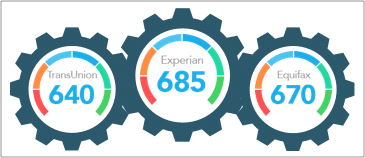Debt-to-income ratio (DTI) is a percentage showing how much of your income goes towards paying debt. The number is determined by dividing the total of all your monthly debt payments by your gross monthly income.
In this article you’ll learn how to calculate your debt-to-income ratio and why it matters to your personal finances.
Lenders Look at Your Debt-To-Income Ratio
Lenders evaluate your DTI to assess your ability to take on additional debt. In fact, your debt-to-income ratio is one of the most important factors determining whether or not you will be approved for a bank loan.
Regardless of how good your credit score might be, if you don’t have any money left over after paying your monthly bills, lenders may view you as high risk that won’t be able to afford any new debt payments.
Typically, the highest debt-to-income ratio that a mortgage lender will approve is 43% for a qualified mortgage but the ideal DTI ratio is usually considered below 36%. Each lender uses its own rules for debt-to-income ratio, but as a whole, the lower the better.
How to Calculate Your Debt-to-Income Ratio
Your debt-to-income ratio compares your debt to your income. The figure helps both you and lenders determine how easily you can pay your bills each month
Here’s how to calculate your DTI ratio:
- Add up all your monthly debt payments, including your rent or house payment, car payment, student loans, credit cards and any other debt. Do not include grocery expenses, gas, utilities and taxes — just payments made against debt owed to another party.
- Divide the total of your debt payments by your total gross income. Gross monthly income is the amount of money you earn before taxes and other deductions .
As an example, let’s say you pay $1,200 each month for rent. Your car runs you another $300 and you owe $500 for all other debts. Add them all together ($1,200 + $300 + $500) and your total monthly debt is $2,000.
If you make $8,000 each month, your debt-to-income ratio is 25% ($2000 is 25% of $8,000.)
What’s the Difference Between Back-End and Front-End DTI?
Lenders may look at two versions of your DTI ratio: front-end and back-end. Front-end refers to how much of your pretax income is allocated for housing-related expenses, including mortgage, property taxes and homeowners insurance. Many lenders might look for a ratio of around 28% to be considered creditworthy.
Back-end DTI is the one most people refer to when talking about debt-to-income ratios.
It includes all debt payments, from your credit cards and auto loans to your mortgage and property taxes and compares it to your pretax income. Do not include utilities, insurance, food and other non-debt expenses in your back-end DTI calculation.
Ideally, your back-end DTI shouldn’t be less than 36% and no more than 43%. A higher debt-to-income ratio could signal to a lender that there is not enough income to pay all debts and everyday expenses.
The Relationships Between DTI and Your Debt?
Debt-to-income ratios do more than allow banks to assess your financial health. Your DTI also helps you get a clearer picture of how much debt you have.
Here are a few basic debt guidelines you might want to consider:
- DTI of 35% or Less: You are managing your debt sufficiently and you should have money left over each month after paying all the bills.
- DTI Between 36% and 49%: This level of debt needs improvement to allow room in the budget for unforeseen expenses. Mortgage lenders may require that you meet additional criteria to secure a home loan.
Incidentally, the Federal Reserve views a DTI of 40% or more as a sign of financial strain.
- DTI of 50% and Above: A DTI this high is a red flag to lower your debt load. With at least half of your income needed to pay the debt, any unexpected costs that pop up could put you in serious financial distress. You may wish to investigate bankruptcy or other debt-relief options.
The Bottom Line
No matter what your debt-to-income ratio is, ultimately, you’re in charge. You don’t have to accept the maximum loan amount a bank extends to you. In fact, less is typically better and may result in less strain on your finances.
Run the DTI calculations from above to determine your ratio and make a plan to reduce your debt.




